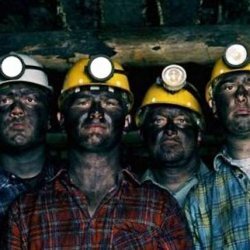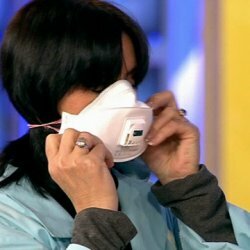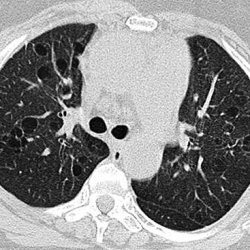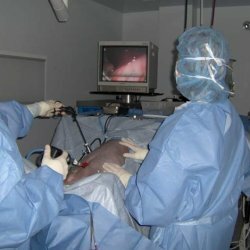Pneumoconiosis of workers in the coal industry
 The harmful effects of dust on humans have been seen back in antiquity. Even at that time it was already known that the work associated with intense dusting, can lead to diseases that are accompanied by a cough with phlegm and often end in a lethal outcome. To such diseases referred "black consumption", "consumption of coalmines."These diseases were described in the works of Hippocrates, Paracelsus, Ramazzini, and in the domestic years of these diseases, wrote AN Nikitin( 1847), F. F. Erisman( 1877god) and many others.
The harmful effects of dust on humans have been seen back in antiquity. Even at that time it was already known that the work associated with intense dusting, can lead to diseases that are accompanied by a cough with phlegm and often end in a lethal outcome. To such diseases referred "black consumption", "consumption of coalmines."These diseases were described in the works of Hippocrates, Paracelsus, Ramazzini, and in the domestic years of these diseases, wrote AN Nikitin( 1847), F. F. Erisman( 1877god) and many others.
The first designation of diseases associated with occupational dust pathologies of the lungs was proposed by F. Zenker in 1866.He introduced the term "pneumoconiosis", which in Greek means pneumon - lung, and conia - dust. Further, many other terms appeared, such as "asbestosis", "siderosis" and many others.
Definition of pneumoconiosis
Pneumoconiosis occurs in people of different professions: miners, machine builders, miners, metalworkers and many others. In this article, we will talk about pneumoconiosis of miners, namely pneumoconiosis, found in workers in the coal industry. In this case, pneumoconiosis is a professional chronic lung disease that occurs as a result of prolonged inhalation of coal dust and sedimentation in the lungs. Often this disease occurs during mining, processing and transportation of coal. It is also important to know that exposure to coal dust can lead to chronic bronchitis, pathological emphysema.
Causes of
Disease Pneumoconiosis provokes:
- chronic inhalation of anthracite and bituminous coal dust( high-carbon coals) for a long time( about 15-20 years);
- quartz inhalation, which is also contained in the coal.
Clinical picture
The disease under consideration is very similar to silicosis. The difference between pneumoconiosis and silicosis is only in the difference and intensity of the symptoms for them and their dynamics of the process. In physical investigations, symptoms of such diseases as emphysema and bronchitis are often found. Also, we should not exclude the microclimate in the mine and the physical load of the miners.
Forms of the disease
There are two forms of the disease:
- A simple form of pneumoconiosis caused by single coal maculae. In patients with pneumoconiosis of simple form, massive fibrosis develops with an approximate frequency of 2%.In this condition, nodules are discharged, black, elastic parenchymal masses are formed in the upper posterior regions of the lungs. Such masses contribute to the disruption of the blood supply and respiratory tract or the transformation into caverns. As a result, massive fibrosis develops and progresses even after the cessation of exposure to coal dust.
- Complicated form of pneumoconiosis, resulting from the discharge of macula and characterized by massive fibrosis.
Pneumoconiosis and possible complications
Pneumoconiosis in miners develops much more slowly than silicosis. The first changes in fluorographic images can be seen only after about 15 years, and sometimes even later, of permanent work in the mine. But as for subjective complaints, they appear usually much earlier than fluorographic changes. But there are cases when, apart from x-ray changes, no other clinical symptoms are observed. The appearance of "tumor-like" changes, rarely observed, contribute to the acceleration of the poor outcome of this disease, a sudden deterioration in the general condition. The cause of death in this case is tuberculosis.
Symptoms of pneumoconiosis
Often, pneumoconiosis is asymptomatic, and all the resulting chronic lung symptoms in miners are caused by some other diseases. This may be associated with industrial bronchitis caused by coal dust, or emphysema, which resulted from smoking. The emerging cough is usually chronic and it worries even after a job change of people, whether they are smoking or not smoking. In the initial stages, this disease is usually characterized by the presence of small darkening with a diameter of no more than 10 mm, found after passing the fluorography. When darkening is more than 1 cm on a fluorographic photograph, such massive fibrosis is already classified in categories A, B and C. Professional massive fibroses can cause progressive dyspnoea, rales, rarely black sputum( melanophthisis), which results from the breakthrough of professional massive sitesFibrosis( PMF) directly into the respiratory tract. As a result of massive fibrosis, tightening of the lungs and decreasing their ability to fully expand, which contributes to the violation of normal gas exchange in the lungs and difficulty breathing. In patients with pneumoconiosis, lips and fingers become bluish with time, fluid accumulates, and symptoms of heart disease appear. Often, progression of PMP is observed until the development of hypertension of the lungs, associated with right ventricular failure.
Diagnosis of pneumoconiosis
The main method of diagnosing pneumoconiosis is an X-ray study. From the history it is necessary to find out the duration of the patient's work in unfavorable conditions associated with increased dustiness, to reveal the characteristics of working conditions, that is, the composition of dust, its concentration in the work area. For an early diagnosis of this disease, miners should annually take a chest X-ray or a large-scale fluorography. X-ray examination of the lungs should be performed with an average inspiration from a distance of approximately 2 m with an exposure of about 0.1 s. This will provide a qualitative image of the lung pattern. To further refine the nature of pneumoconiosis, tomography, x-ray functional studies, and enlarged images are used. The radiological picture will depend directly on the form of pneumoconiosis.
Treatment of pneumoconiosis
For the treatment of pneumoconiosis of a simple form, it is first of all necessary to stop smoking and it is recommended to observe tuberculosis. Patients with pulmonary hypertension or with pulmonary hypoxemia are prescribed additional oxygen therapy. Pulmonary rehabilitation can help workers with diseases of a more severe form to withstand daily physical activity.
Prevention of pneumoconiosis
For preventive measures it is necessary:
- to eliminate the effects of dust;
- stop smoking;
- get vaccinated against pneumococcus and influenza;
- use respiratory mask;
- patients with complicated form pneumoconiosis need to change their place of work.



